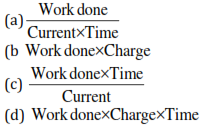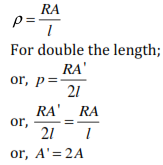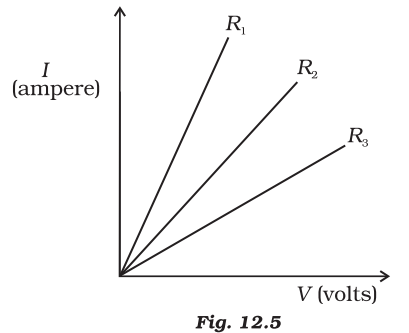
Electricity mcq 1
9. Which of the following represents voltage?

Ans a
10. A cylindrical conductor of length l and uniform area of cross section A has
resistance R. Another conductor of length 2l and resistance R of the same
material has area of cross section
(a) A/2
(b) 3A/2
(c) 2A
(d) 3A
Ans. (c) 2A
Explanation: Both the conductors are of same material hence their resistivity is
same.

11. A student carries out an experiment and plots the V-I graph of three samples
of nichrome wire with resistances R1 R2 and R3 respectively (Figure. 12.5).
Which of the following is true?

(a) R1= R2= R3
(b) R1> R2 > R3
(c) R1> R2> R3
(d) R1 > R2 > R3
ANS C
Explanation: Current is inversely proportional to resistance. So, higher
resistance would allow less current to pass; which is shown by resistance R3.
12. If the current I through a resistor is increased by 100% (assume that
temperature remains unchanged), the increase in power dissipated will be
(a) 100 %
(b) 200 %
(c) 300 %
(d) 400 %
Ans. (c) 300 %
Explanation: The heat generated by a resistor is directly proportional to square
of current. Hence, when current becomes double, dissipation of heat will
multiply by 22 =4. This means there will be an increase of 300%.
13. The resistivity does not change if
(a) the material is changed
(b) the temperature is changed
(c) the shape of the resistor is changed
(d) both material and temperature are changed
Ans. (c) the shape of the resistor is changed
14. In an electrical circuit three incandescent bulbs A, B and C of rating 40 W,
60 W and 100 W respectively are connected in parallel to an electric source.
Which of the following is likely to happen regarding their brightness?
(a) Brightness of all the bulbs will be the same
(b) Brightness of bulb A will be the maximum
(c) Brightness of bulb B will be more than that of A
(d) Brightness of bulb C will be less than that of B
Ans. (c) Brightness of bulb B will be more than that of A
Explanation: Since bulbs are connected in parallel so resistance of combination
would be less than arithmetic sum of resistance of all the bulbs. So, there will
be no negative effect on flow of current. As a result, bulbs would glow
according to their wattage.
15. In an electrical circuit two resistors of 2 O and 4 O respectively are
connected in series to a 6 V battery. The heat dissipated by the 4 O resistor in
5 s will be
(a) 5 J
(b) 10 J
(c) 20 J
(d) 30 J
Ans. (c) 20 J
Explanation: Total resistance of combination =2 Ω + 4 Ω = 6Ω
Current through the circuit can be calculated as follows:
I = V / R
= 1A
Heat dissipation by 4Ω can be calculated as follows:
H = I2 RT = (IA)2 x 4Ω x 5s = 20 J
16. An electric kettle consumes 1 kW of electric power when operated at 220 V. A
fuse wire of what rating must be used for it?
(a) 1 A
(b) 2 A
(c) 4 A
(d) 5 A
Ans. (d) 5 A
Explanation: Power=1 kW= 1000W
Current flowing through the kettle can be calculated as follows:
P = V x I
Or 1000W = 220 V x I
Or I = 1000w / 220V = 4.24A
So, required rating of fuse wire=5A
17. Two resistors of resistance 2 Ω and 4 Ω when connected to a battery will
have
(a) same current flowing through them when connected in parallel
(b) same current flowing through them when connected in series
(c) same potential difference across them when connected in series
(d) different potential difference across them when connected in parallel
Ans. (b) same current flowing through them when connected in series.
Explanation: In series combination, current does not change because each
resistor receives a common current. In other words, current does not get divided
into branches.
18. Unit of electric power may also be expressed as
(a) volt ampere
(b) kilowatt hour
(c) watt second
(d) joule second
Ans. (b) kilowatt hour